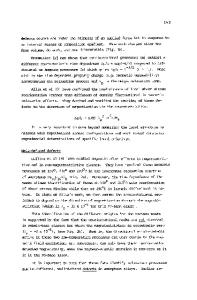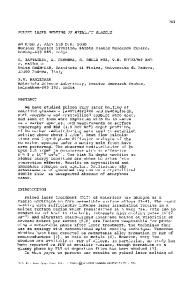Structural Aspects of Metallic Glasses
- PDF / 374,934 Bytes
- 6 Pages / 585 x 783 pts Page_size
- 81 Downloads / 367 Views
of Metallic Glasses
Daniel B. Miracle, Takeshi Egami, Katharine M. Flores, and Kenneth F. Kelton Abstract A recent structural model reconciles apparently conflicting features of randomness, short-range order, and medium-range order that coexist in metallic glasses. In this efficient cluster packing model, short-range order can be described by efficiently packed solute-centered clusters, producing more than a dozen established atomic clusters, including icosahedra. The observed preference for icosahedral short-range order in metallic glasses is consistent with the theme of efficient atomic packing and is further favored by solvent-centered clusters. Driven by solute–solute avoidance, medium-range order results from the organization in space of overlapping, percolating (via connected pathways), quasi-equivalent clusters. Cubic-like and icosahedral-like organization of these clusters are consistent with measured medium-range order. New techniques such as fluctuation electron microscopy now provide more detailed experimental studies of medium-range order for comparison with model predictions. Microscopic free volume in the efficient cluster packing model is able to represent experimental and computational results, showing free volume complexes ranging from subatomic to atomic-level sizes. Free volume connects static structural models to dynamic processes such as diffusion and deformation. New approaches dealing with “free” and “anti-free” microscopic volume and coordinated atomic motion show promise for modeling the complex dynamics of structural relaxations such as the glass transition. Future work unifying static and dynamic structural views is suggested.
Introduction An accurate description of atomic structure underpins our understanding of condensed solids. Experimental techniques provide atomic structure in even the most complicated crystalline and quasicrystalline materials, so an accurate, detailed structural description is often taken for granted. Far less is known in amorphous solids, where the loss of identifiable symmetry decimates the information available from experiments. Despite this lack of information, insights taken from constraints of charge neutrality and covalent bonding, together with seven decades of dedicated research, offer a good representative structure for oxide glasses,1 although unanswered questions remain.2 Metallic glasses suffer from a similar loss of symmetry, but lack the covalent bond angle constraints that helped establish oxide glass structural models. As a result, until recently no representative structural model was able to describe even the most basic metallic glass
characteristics. Contributing to this confusion is the struggle to conceptually reconcile the defining feature of atomic disorder with undeniable evidence of strong short-range order (SRO) and surprising medium-range order (MRO). This article provides a current review of recently published research on the structure of metallic glasses. A recent static structural model described in the following section reconciles
Data Loading...











